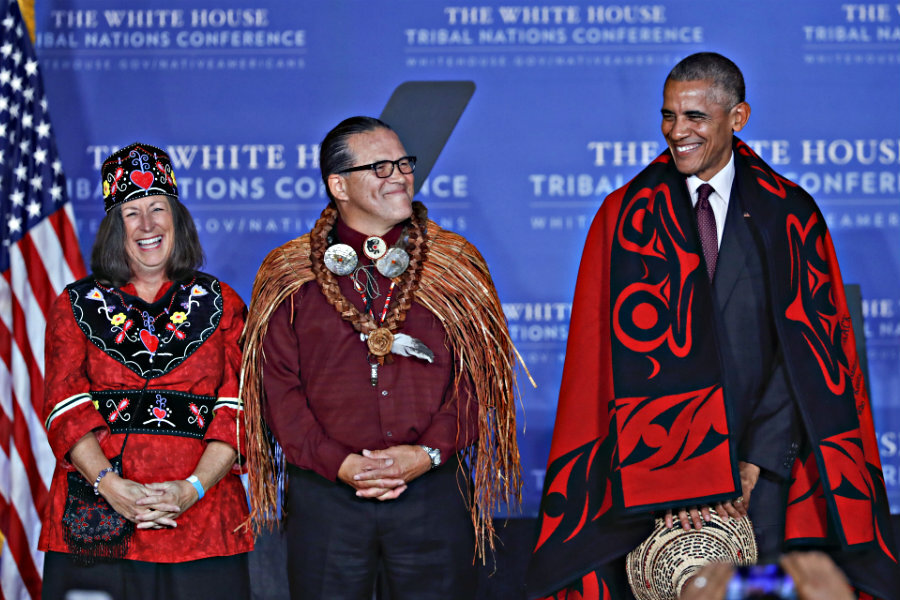Why the US government will pay native Americans almost half a billion dollars
Loading...
The Department of the Interior and the United States Attorney General announced this week that the federal government will pay 17 native American tribes $492 million, settling claims that the government mismanaged tribal resources for years.
This week’s settlement is the latest in a series of similar agreements with more than 100 tribes in total, as the federal government attempts to chart a new course in tribal relations and dispute resolution.
Although native American tribes have called attention to these issues for decades, this week’s resolution is representative of the federal government’s changing approach towards federal disputes with tribal governments, some experts say.
"The fact that the Obama administration is working with these groups reflects a general feeling that the government should work with native American tribes, rather than against them," Bethany Berger, a scholar of federal Indian Law at the University of Connecticut, tells The Christian Science Monitor. "The willingness to accept responsibility for government actions is very significant, and has not characterized previous administrations."
The problem of government mismanagement of native American lands, money, and resources stems back to the earliest interactions between native Americans and European empires, Kathleen DuVal, a professor at the University of North Carolina who specializes in the early cross-cultural history of North America, tells The Christian Science Monitor.
Over the course of US history, many agreements with native Americans have made the federal government the trustee for tribal land. The Department of the Interior manages almost 56 million acres, and controls tens of thousands of leases for industries like cattle grazing and lumber to use the property. But it has mismanaged those funds, tribes argue, depriving them of their "just compensation" for use of the land.
“The federal government has held tribal property in trust for almost 200 years,” says Ms. Berger, “and they’ve almost never handled it properly.”
With the government’s announcement of a $492 million settlement for that mismanagement, the government has nearly concluded a long series of lawsuits that began in the 1980s concerning government mismanagement.
Unlike recent settlements, however, past allegations of government mismanagement of native American lands and funds often led to lengthy legal battles, with at least one timber management case, United States v. Mitchell, making it to the Supreme Court in the 1980s.
In the mid-1990s, native American representatives brought Cobell v. Salazar against the United States, often considered the largest class action lawsuit in US history. It was finally settled for $3.4 billion, after more than a decade of legal battles, in 2009.
Since then, the government has settled more than a billion dollars worth of mismanagement charges, with major settlements in both 2012 and 2014. The settlements announced this week stem from an initiative begun during the summer, signaling the government's new eagerness to quickly move forward on mismanagement allegations.
The settlements have an impact that goes farther than government management practices, native advocates say: after decades, even centuries, of often fruitless complaints, some tribes feel as though they have finally been heard.
“It’s a huge deal when you can sit down with the tribal leaders and see in their faces what this settlement will mean for their tribes and the fact they think they are being heard for the first time in a meaningful way,” the Justice Department’s Jim Gette told The Washington Post.
In its announcement of this week’s 17-tribe settlement, the federal government acknowledged the damage from past mismanagement, but said that it is looking toward a future of better partnership and trust with American Indian groups.
“As we turn the page on past challenges in our government-to-government relationship with tribes, we’re moving forward with tribal governments to ensure proper management of tribal trust assets,” Department of the Interior secretary Sally Jewell said in a statement.
As of today, the federal government has settled with more than 100 tribal groups for a total sum of more than $3.3 billion dollars, with the majority of the previously-outstanding claims settled under the Obama administration.
As a result of the lawsuits, the federal government and tribal groups have agreed to information sharing procedures and dispute resolution provisions to prevent future mismanagement suits, seeking instead to move towards reconciliation.
"There is much left to do to achieve anything close to reconciliation," Dr. DuVal tells the Monitor, saying she is cautious, but hopeful, about the possibility of change. "But it is beginning at the right place by listening to Indians today, respecting tribal rights as nations, and abiding by treaties."








